There’s little doubt that LEDs save energy, but the high initial cost of LED lamps is preventing mass adoption by lighting consumers. New materials are crucial to driving down the price tag and driving up market acceptance.
The price of LEDs has come down rapidly over the past three years, and this trend is expected to continue over the next couple of years until LED lamps reach mass adoption cost. Essential research into better materials is crucial for reaching this price goal – but beyond that, advances in materials will also broaden LED consumption into new markets and application areas.
The LED market continually demands more in terms of brightness, lifetime (concerning brightness and color maintenance), and color homogeneity or color rendering. Some of the main challenges are being addressed by innovative materials research.
Reduction of droop
Perhaps the biggest burden facing LED makers is the dreaded droop: a curious performance glitch that causes an LED’s efficiency to decline as the current that passes through it is increased.
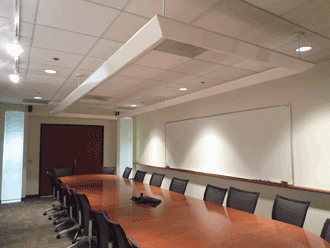
The original conference room with fluorescent general and incandescent accent lighting, before installation of the DC infrastructure system with LED lighting. Photo courtesy of Lighting Research Center.
Materials that promise to alleviate the problem are semipolar GaN (gallium nitride) and nonpolar GaN. The hope is that these substrates will enable improved efficiency under typical (>350 mA/mm2) or higher-power conditions and result in a significant reduction in the overall cost of light.
“It is essential to eliminate or minimize droop so that LEDs can be operated at high current density, so that fewer LEDs are needed per package. This ultimately drives down the dollar-per-lumen value,” said Dr. Bedwyr Humphreys, chief technology officer at Seren Photonics in Bridgend, Wales. “Semipolar and nonpolar materials also have the potential to enable new devices such as GaN VCSELs [vertical-cavity surface-emitting lasers] and normally off GaN HEMTS [gallium-nitride-based high-electron-mobility transistors].”
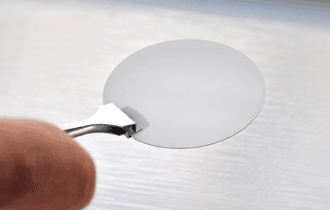
A 2-in. semipolar gallium nitride template grown on sapphire. Photo courtesy of Seren Photonics.
Improved thermal performance
This particular issue concerns the entire LED system as a whole (i.e., the die, attach materials, silicones and phosphors): All must work together to enable higher operational temperatures.
“Thermal management is a critical factor in today’s LED lighting devices,” said Michael Green, global business development manager at DuPont Circuit & Packaging Materials in Research Triangle Park, N.C. “Despite the lighting industry’s ability to provide more lumens per watt than ever before, an LED’s reliability and performance depend greatly on how it is packaged and mounted. In order to deliver on the value proposition of a long lifetime, LED lighting manufacturers have to be able to dissipate heat efficiently.”
At Osram Opto Semiconductors Inc. of San Jose, Calif., researchers are working on this in response to the increasing operating temperature of LEDs. High temperature stability of the incorporated materials is essential to ensuring a long LED lifetime, together with high color stability.
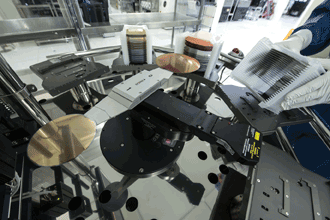
At Osram Opto Semiconductors’ cleanroom in Regensburg, Germany, 6-in. wafers are being regrouped for red, yellow and orange LED chips. Photo courtesy of Osram Opto Semiconductors.
“Suitable materials are, for example, aging-free, possessing high-refractive-index (>1.54) encapsulants with good thermal conductivity as well as high-reflective, light- and temperature-stable housing materials,” said Dr. Berthold Hahn, senior director of R&D chip technology at Osram. “Superior heat dissipation by means of using low-thermal-resistance (Rth) substrates as well as low-Rth interconnect materials is also essential.”
Advanced inorganic phosphors (with high quantum efficiency, low remission/thermal-quenching, controlled scattering and defined spectral properties) or alternative phosphor solutions (quantum dots, for example) are also important contributors.
For highly efficient warm-white or RGB solutions, the development of temperature-stable red-emitting technology is essential. This is particularly relevant to the aluminum indium gallium phosphide (AlInGaP) structures used today, which show a much lower temperature stability compared with indium gallium nitride (InGaN) devices. AlInGaP devices require high effort in color control, and the efficacy in the high-temperature regime is limited.
Flexibility in the substrates is another avenue of research for manufacturers. As materials continue to get thinner and adhesive systems more robust, designers eventually will be able to integrate circuitry with thermal management and heat sinks.
For example, the DuPont CooLam thermal substrate is made with a polyimide dielectric specially designed to have low thermal resistance and flexibility. “CooLam dissipates heat more rapidly and more reliably than conventional filled epoxy-based boards,” Green said. “CooLam 3D, DuPont’s bendable thermal substrate, allows designers to direct light output and create omnidirectional light without the use of optics.”
Improved color rendering
New phosphor materials – specifically, narrowband reds (<50 nm full width half maximum [FWHM]) – will be needed to derive the same performance when increasing the CRI (color rendering index) to 90, according to Dr. Jy Bhardwaj, senior vice president for R&D at Philips Lumileds of San Jose.
For performance enabling greater than 10 percent efficacy improvement at the same CRI, Bhardwaj said that new narrowband red phosphor materials (<40 nm FWHM) will be needed.

The Luxeon Altilon LED, which is used for automotive lighting such as in this Audi headlight. Photo courtesy of Philips Lumileds.
New materials broaden LED appeal
With current LED performance nearing or surpassing that of most traditional light sources, LEDs are now addressing most lighting applications (indoors, outdoors, transportation vehicles and so on). However, changing the existing installed base is costly – and that’s one reason every application is not rapidly changing to LED. But costs are coming down as new LED materials are engineered, so the foothold in the lighting market is expected to strengthen, and the list of applications will certainly expand.
“Automotive headlamps have [been] the last automotive application to transition to LEDs,” Bhardwaj said. “High-power, high-luminance LEDs are now being designed into luxury and midrange vehicles, and new technologies and materials will expand this to the high-volume entry-level vehicles sector in the next few years.”
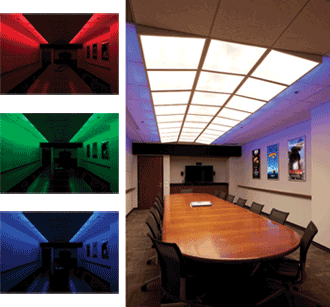
The conference room demonstration with different lighting effects produced by the DC-powered infrastructure system for LED lighting. Photo courtesy of Lighting Research Center.
Other high-luminance applications such as projection systems could also be enabled by key new materials developments.
“High-CRI full-BBL [blackbody line] tunable modules at low enough cost points for high- to mid-end consumer applications could also be enabled within the next couple of years,” Bhardwaj said.
At the Lighting Research Center at Rensselaer Polytechnic Institute (RPI) in Troy, N.Y., scientists are moving beyond static light fixtures to systems that can change based on occupant needs – the ultimate in personalized lighting.
“Parameters such as intensity, spectrum and distribution – spatial and temporal – are all important to meeting occupant needs,” said Dr. Nadarajah Narendran, professor and director of research at RPI’s Lighting Research Center. “Also, with longer life potential, we need reliable LEDs that can be embedded within our building infrastructures so that the fixtures don’t look like an afterthought and are easy to change and upgrade.”
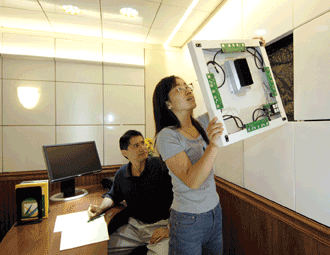
A first-concept model of the low-voltage, DC-powered interior infrastructure system built at the Lighting Research Center’s laboratory in 2005. Photo courtesy of Lighting Research Center.
The Lighting Research Center, together with product engineers at Osram, recently completed a demonstration project where a prototype interior infrastructure for lighting was installed in a conference room; the setup allowed LED lighting to be easily moved and changed by the room’s users.
LEDs were embedded into 2 × 2-ft metal ceiling and wall tiles, which can be customized to fit into typical room geometries or into diverse architectural designs such as wall and ceiling curves. To manage the system’s heat and to ensure maximum life and lumen maintenance, LEDs were mounted to metal plates and housings to extract heat.
“To summarize, energy savings is a done deal for LEDs over traditional lighting. It is the other benefits, such as size, ruggedness, flexibility, tunability and personalization, that will further expand LED use going forward,” Narendran said. “New opportunities – innovative concepts and applications that only LED lighting can fulfill – will demand improvements in other parameters besides energy (e.g., spectrum, distribution, intensity, etc.), and, in turn, this will lead to demand for new materials.”
Taking LEDs to the Next Level
Dr. Nadarajah Narendran, professor and director of research at RPI’s Lighting Research Center, provides an overview of what needs to be done to take LEDs to the next level, and of the challenges that remain:
“We need innovations at several stages, including the chip, the encapsulant [and] phosphors as well as the total LED package. Also, beyond the LED package, the drive electronics, light distribution optics and the final lighting fixture also need innovation. These innovations could be related to material and/or manufacturing.
“Right now, we have LED products in the commercial market at 150+ lm/W. The next level is commercial white LEDs at 200 lm/W.
“Globally, lighting uses up to 20 percent of the electric energy used by all sectors, and the demand keeps growing. LED holds the promise of saving 50 percent of lighting’s energy use. So the ultimate goal is to save greater than 50 percent electric energy presently used by lighting at similar light levels.
“It is worth pointing out that creating a light source twice as efficient as the most efficient traditional light sources does not guarantee 50 percent savings for lighting energy demand. There are many reasons for this – some have negative effects, while others have positive effects. For example, lighting fixtures used for illuminating our spaces don’t use 100 percent of the light produced by the source to illuminate the area of interest. Some percentage of the flux doesn’t leave the lighting fixture at all, while some percentage of the light leaving the fixture ends up in the wrong place.
“Therefore, better-designed optical elements with higher-quality materials can effectively deliver the light to where it is needed. In this regard, fixtures typically used in directional lighting applications can benefit from smaller-size light sources that enjoy a higher percentage of flux reaching the place where it is needed.
“This is the reason why it is an obvious choice to use LED sources in downlight fixtures, rather than CFL. For example, a 75-W downlight commonly used in buildings, homes and commercial spaces can be replaced by a 30-W CFL fixture or a 12-W LED fixture, with over 80 percent energy savings. With better beam-control ability, LEDs are a much better choice for the application.”